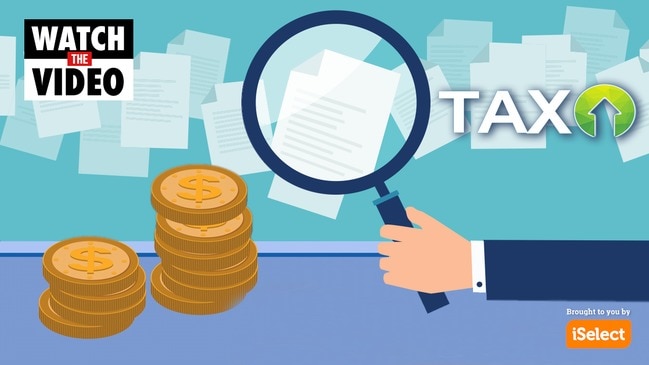Barefoot Investor: New YourSuper ATO tool is a good first step to see if you’re in a dud fund
Scott Pape isn’t sorry he pointed Australians to an ATO tool that could help them. Now he’s found a new way to help build on retirement savings.

Barefoot Investor
Don't miss out on the headlines from Barefoot Investor. Followed categories will be added to My News.
I got absolutely belted for last week’s column.
My crime?
Innocently suggesting that people with uncomplicated tax affairs (read ‘employees’) could save themselves the $400 they spend on an accountant, and instead lodge via the ATO app on their phone, which does the job in a few minutes.
This did not go down well in accounting circles.
Neil, a suburban accountant, wrote to me saying: “You’re nothing but a government stooge for promoting their tools. You should be ashamed of yourself. You disgust me.”
WHAM! Neil sure wants to give me a bit of negative gearing alright, SMACK BANG in the kisser!
(On second thoughts, maybe Neil’s the accountant you want. He’ll FIGHT for every deduction.)
So, while I have Neil’s attention, let’s put another pot on the stove and get his blood boiling.
This week the Government has released another tool, this time for superannuation.
And you know what? It’s pretty darn good.
It’s called ‘YourSuper’ (ato.gov.au/yoursuper) and it helps you compare super funds.
Actually, it’s real value is that it’ll tell you whether you’re in a dud fund.
And that one bit of information is incredibly valuable: it can stop you from having hundreds of thousands of dollars of your retirement savings smoked by high fees and poor performance.
The fact that it took the Government 30 years to create a website that tells consumers this vital information is absolutely outrageous. Still, credit to Senator Jane Hume for pushing it through and finally getting it done.
If you access it through your myGov, you can check for lost super, consolidate your accounts, and shop for a cheaper fund (costs are the one thing that investors can control).
It’s another nail in the coffin for hopeless funds that should have been shut down long ago … and that’s good news in my book. It’s not perfect, and only covers MySuper products at this stage. And the data on the dud funds won’t be out until later in the year … but it’s a great first step.
So here’s my tip: when you’re lodging your return in a month’s time, check out your super … after all, it’s the same site, right Neil?
Tread Your Own Path!
Bonjour Barefoot!
Hello Scott,
I am a French mum of four. I learned about you through a podcast of a young lady who calls herself Madame Fauchée (fauchée in French means broke!). So I wanted to buy your two books. But it is impossible to get them in France, so I bought your mp3s and listened while riding my bike to work. Your books are so interesting! I wish I had read them earlier. Now I would like to get my sons into them — particularly my youngest, who is 16. Is it still possible to do the Barefoot family with a 16-year-old? Finding a job at this age is not easy in France, especially at this time of Covid.
Merci, Suzanne
Hi Suzanne,
Frais!
(My son is learning French at school at the moment and he tells me that means ‘cool’!)
In Australia I’ve been piloting a program in high schools for students who are the same age as your son.
The program is called ‘The Bucket List’ and it involves students saving up for something on their bucket list (it could be a bike, travel, or moving out — whatever chews their croissant).
The way they get their money is by working (a key lesson!), at which point most kids fold their arms and say “There aren’t any jobs!” (It’s not just a French thing). However, there’s always work for teenagers (because they’re cheap!). The trouble is, most don’t apply, or put in much effort.
So I get kids to do my Zero to Hero Résumé (which is also in my Barefoot Investor for Families book). The aim is to get them to write down positive things about themselves and learn how to sell themselves at a job interview. For your son, the aim is to have him earn his own money, set up his Barefoot buckets straight away, and start saving for a goal. You want him to get that feeling of winning, quickly.
Another challenge from the Bucket List program is to get your son to help you cut the costs of your household bills by negotiating a cheaper energy or phone provider. You could even offer to pay him a commission.
Here’s the end game: most parents complain about their teenagers — they’re lazy, they sleep all the time, and they have no idea about money or the real world.
I want you to brag about your son while he’s in earshot — how good he is at saving you money, how hard a worker he is, and how he wants to get a part-time job. He may act like he’s not hearing you, but he will take it in.
Au revoir!
The ASX Game
Dear Scott,
My daughter recently brought home a consent form for me to sign. She is in Year 12 and, as part of Pathways and Wellbeing (PAW) this semester, the students are learning about investing in shares by playing the ASX Sharemarket Game. They are given $50,000 virtual money to invest over a 10-week period. Since reading your book in 2020, I have been investing in the ASX but not trading. My concern is that it is not focusing on long-term investment. So should I sign the form?
Meg
Hi Meg,
Yes, you should sign the form!
This sounds like fun … and I think your daughter will end up a winner.
Do you know why?
Because she’s going to have a secret helper with the ASX game:
Me!
Here’s how I’d suggest she plays:
Put $25,000 in the Vanguard Australian Shares Index ETF (ASX code: VAS). Or, if she prefers a greener option, the Vanguard Ethically Conscious Australian Shares ETF (ASX code: VETH).
Then put $25,000 in the Vanguard MSCI Index International Shares ETF (ASX code: VGS). Or, again, if she wants a sustainable option, try the Vanguard Ethically Conscious International Shares Index ETF (ASX code: VESG).
With those two investments she’ll own shares in the largest companies in Australia and the world, and all for rock-bottom fees. She can school her teacher and explain that the overwhelming evidence suggests that she’s all but guaranteed to outperform her stock-picking pals over the long run (though I’m talking years … not weeks).
Then she can use the next 10 weeks to read The Barefoot Investor. In fact, I’ll donate a signed copy to the school library!
Thanks From Spider-Man
Hi Scott,
Here is a pic of my five-year-old, who started the Jam Jars last year and saved up enough to replace his broken Garmin band (he accidentally cut it with scissors at school last week) with a Spider-Man band. He received a double-edged lesson in saving AND in looking after his things.
I read both The Barefoot Investor and The Barefoot Investor for Families a year after becoming a single mum. You revolutionised the way I conceptualise saving and I’ve since gone on to buy a house and build up my Mojo. “Don’t spend more than you earn.” It’s such a simple lesson, yet it’s not a lesson I was ever taught growing up.
Lisa
Hi Lisa,
What a little champion! This is the reason I came up with the Money Movement — I want this for every Aussie kid. You made my day.
Information and opinions provided in this column are general in nature and have been prepared for educational purposes only. Always seek personal financial advice tailored to your specific needs before making financial and investment decisions
The Barefoot Investor for Families: The Only Kids’ Money Guide You’ll Ever Need
(HarperCollins) RRP $29.99
If you have a money question, go to barefootinvestor.com and #askbarefoot.
Join Barefoot’s mission to set up Aussie kids for life:
Scott Pape’s Money Movement, 8:30pm AEST Wednesday on Foxtel Lifestyle and on demand
Originally published as Barefoot Investor: New YourSuper ATO tool is a good first step to see if you’re in a dud fund


